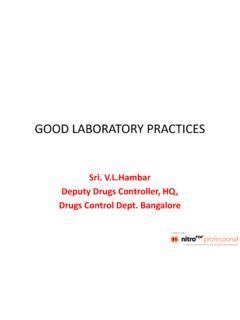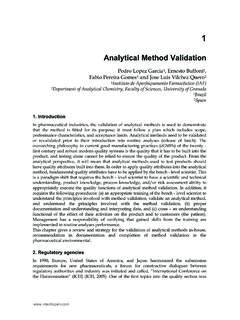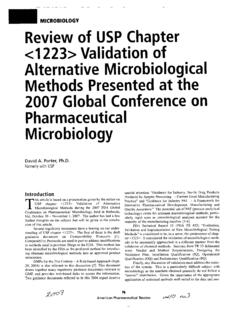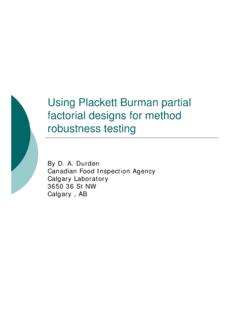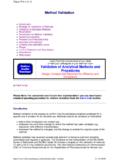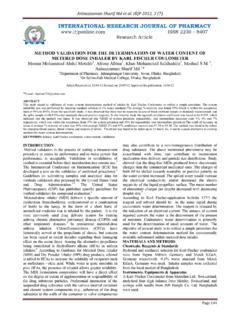Transcription of A Tutorial Discussion of the use of the terms Robust and ...
1 Journal of the Association of Public Analysts (Online) 2009 37 40-60 D Thorburn Burns et al -40- A Tutorial Discussion of the use of the terms " Robust " and "Rugged" and the Associated Characteristics of "Robustness" and "Ruggedness" as used in Descriptions of Analytical Procedures Duncan Thorburn Burns1, Klaus Danzer2 and Alan Townshend3 1 School of Chemistry,The Queen's University of Belfast, Belfast BT9 5EB, N. Ireland, UK 2 Institute of Inorganic and Analytical Chemistry, Friedrich Schiller University of Jena, Lessingstrasse 8, Germany 3 Department of Chemistry, The University of Hull, Hull, HU6 7RX, UK Summary The terms Robust and rugged are clearly defined and their uses distinguished along with the associated characteristics of robustness and ruggedness.
2 It is shown that the characteristics of robustness and ruggedness which express resistance against conditions and influences which decrease both precision and accuracy of analytical results, obtained by a particular procedure in a given laboratory or in different laboratories, can be treated quantitatively by the introduction of two new concepts, namely, relative robustness and relative ruggedness. Introduction There is considerable confusion in the scientific journal and monograph literature with regard to the use of the terms Robust and rugged and of the associated characteristics robustness and ruggedness as applied to the description of analytical methods. Many authors use the two terms and their associated characteristics as if they were synonymous [1-22].
3 Others use only one term and/or characteristic, namely Robust /robustness [23-38] or rugged/ruggedness [39-57]. A few authors distinguish their use as between the areas of intra- and inter-laboratory studies [58-68] or restrict the use of Robust / robustness to the statistical interpretation of data and of rugged/ruggedness to experimental design of intra-laboratory studies prior to a collaborative trial [69]. The use of the term Robust in connection with statistical tests on data is supported by many chemists and statisticians [70-77]. Prior to the present study these terms and the associated characteristics of these terms have not been defined by IUPAC, ISO or similar bodies. Indeed, within IUPAC documents confusion exists with the use of ruggedness, in one case [45] the explanation of ruggedness implies an inter-laboratory use, by giving laboratories in the list of variables, whereas in a later document [53], ruggedness is used in a single-laboratory situation.
4 The International Conference on Harmonization of Technical Requirements for Registration of Pharmaceuticals for Human Use (ICH) defines Robustness as follows: "The robustness of an analytical procedure is a measure of its capacity to remain unaffected by small, but deliberate variations in method parameters and provides an indication of its reliability during normal usage." [23, 24]. They state this should be evaluated at the development stage Journal of the Association of Public Analysts (Online) 2009 37 40-60 D Thorburn Burns et al -41- from intra-laboratory experimentation and list examples of typical variations, those for liquid chromatography and for gas chromatography to be examined. The British Pharmacopoeia (BP) [38] additionally gives a list of challenges to the normal operating procedure for robustness testing a procedure which uses infrared spectrophotometry.
5 The US Pharmacopeia National Formulary ( ) [59] has adopted the ICH definition of robustness and defines Ruggedness as: "The ruggedness of an analytical method is the degree to of reproducibility of test results obtained by the analysis of the same samples under a variety of conditions such as different laboratories, different analysts, different instruments, different lots of reagents, different elapsed assay times, different assay temperatures, different days, etc. Ruggedness is normally expressed as the lack of influence of operational and environmental factors of the analytical method. Ruggedness is a measure of reproducibility of test results under the variation in conditions normally expected from laboratory to laboratory and analyst to analyst.
6 " This definition clearly refers to inter-laboratory studies. The ICH and the give procedures for the qualitative evaluation of robustness and ruggedness, respectively, but not for their numerical determination. Wahlich and Carr [58], whilst discussing chromatographic system suitability tests, appear to be the first to use ruggedness (defined as the effect of operational parameters on the methods suitability) and robustness (referred to as the method s suitability to be transferred to another laboratory) in a hierarchical sense. The areas of application of these two characteristics were reversed by Zeaiter et al. [63] in a Discussion of the robustness of models developed by multivariate calibration for infrared spectroscopic data. They noted the confusion in the literature with the use of the characteristics ruggedness and robustness and that ruggedness was a property hierarchically above robustness as put forward by the Canadian Drugs Directorate in their three level testing system.
7 In this system Level I refers to the ICH (intra-laboratory) definition of robustness [23] and should include verification of reproducibility by using a second analyst. In Level II testing, the effects of more severe changes in conditions are examined when the method is intended to be applied in a different laboratory with different equipment. Level III considers "a full collaborative testing", which is rarely done. The only official document to distinguish the use of robustness and ruggedness is the [59]. The definition for robustness in the and in the British Pharmacopoeia have their origin in the ICH documents CPMP/ICH/381/95 [23] and CPMP/ICH/281 [24]. The material in CPMH/ICH/381/95 also appears in the official Federal Register of the Food and Drug Administration [27].
8 The European Commission only refer to one characteristic for analytical methods, namely ruggedness [52], for the outcome from what is clearly an intra-laboratory test. Thus the European Commission and others [39 57] are out of line with what has been said to be traditional usage [61], namely robustness for the outcome from an intra-laboratory test, as recommended herein. This usage is consistent with the earlier IUPAC description of ruggedness which implied an inter-laboratory experiment [46]. To produce a Robust or a rugged analytical procedure it is essential that the instruments used Journal of the Association of Public Analysts (Online) 2009 37 40-60 D Thorburn Burns et al -42- in the analytical procedure produce acceptable data. The process of ensuring the precision and accuracy of an analytical instrument used in an analytical procedure and its descriptive terminology has been recorded by Bansal et al.
9 Following an American Association of Pharmaceutical Scientists (AAPS) workshop, A Scientific Approach to Analytical Instrument Validation [78]. The participants agreed that the term validation should be used to refer to the overall analytical process, and that the term qualification be used for the procedure for ensuring that an instrument was producing data of the required precision and accuracy. Although the literature cited above refers almost exclusively to the analysis of pharmaceutical products, the clear distinction between the descrpitors Robust and rugged is of wider application in other fields of analysis for regulatory purposes such those of human foods, animal feedstuffs, environmental samples and of artricles subject to tariff/customs control.
10 Definitions The following definitions are now recommended: Robust / Robustness / Relative Robustness: A Robust analytical method is one which exhibits a high degree of robustness as determined in an intra-laboratory study. Robustness of an analytical method is the property that indicates insensitivity against changes of known operational parameters on the results of the method and hence its suitability for its defined purpose. This is ascertained during the method development processes and determines the allowable (acceptable) limits for all critical parameters that affect measured values for analytes and provides information on a method s practability. It may be defined by the value of a method s Relative Robustness. The Relative Robustness of an analytical method is defined as the ratio of the ideal signal for an uninfluenced method compared to the signal for a method subject to known operational parameters as determined in an intra-laboratory experiment [see equation (4) below].
